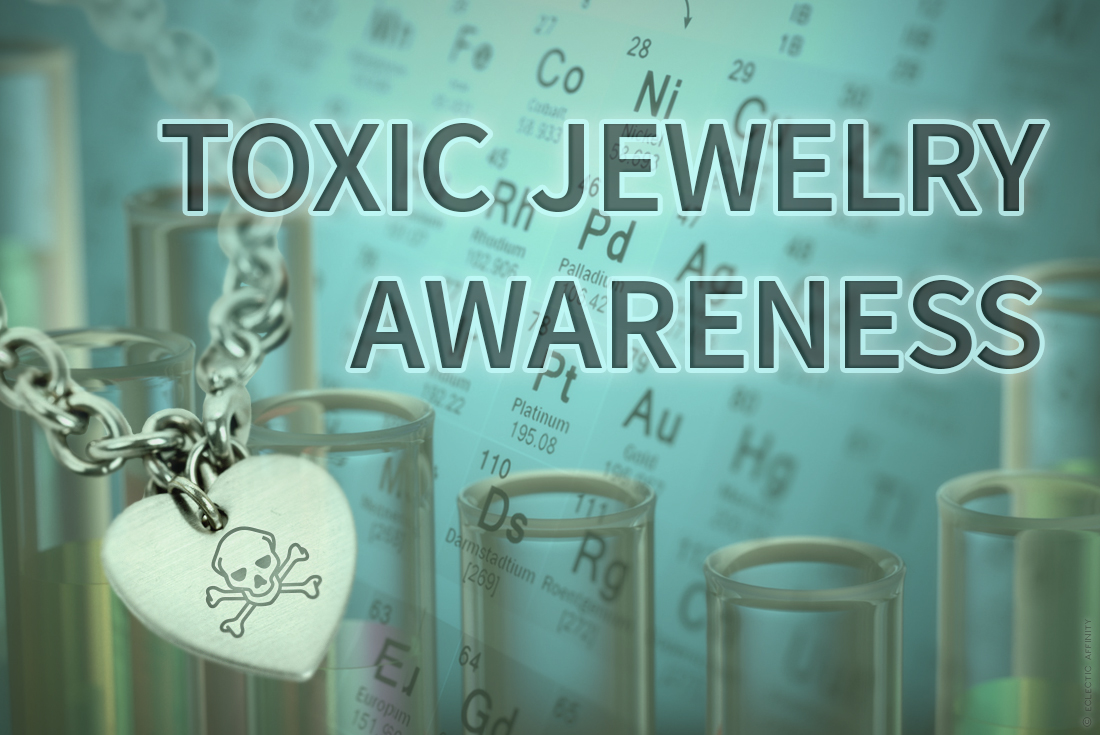In recent years, it’s become more widespread knowledge that cosmetic and skin care products and even clothes sometimes contain elements that our skin can absorb into our bodies with adverse effects. However, there’s something that’s often missing from that list. Jewelry doesn’t generally come with an ingredient label, so it’s an easy one to overlook. Only in the last several years has toxic metal regulation become a real topic of interest as it pertains to jewelry and accessories, and those regulations vary. California was the first state to pass legislation affecting standards of toxic and heavy metals in jewelry. That’s a step in the right direction, but it should be noted that regulations surrounding jewelry and children only apply to jewelry intended and labeled specifically for children’s use (in the specific legal language within “California’s Metal-Containing Jewelry Law,” that’s defined as persons age 6 and younger, although in other circumstances the legal definition of “child” can have a blanket age of anyone age 14 and younger). That means that the necklace you’re wearing might legally be deemed safe enough for you to wear and handle, but it might have components that aren’t meant to be handled by the small child in your arms. If you’re thinking “nah, none of my jewelry could be affected,” check out these slideshows of adult and children’s jewelry and accessories found to have dangerously high levels of lead. The samples look uncomfortably familiar.
What’s wrong with lead and other heavy metals; why do I need to know about this?
Heavy metals like lead and cadmium are neuro-toxic elements that can bioaccumulate in the body. Exposure to them has been linked to such adverse effects as developmental problems, behavioral problems, learning disabilities, organ damage or failure, cancer, and even death. Heavy metal exposure is especially harmful for unborn babies and young children, as they are growing and developing very rapidly at those stages.
Many might presume since you’re not swallowing jewelry, it’s probably okay. Putting aside for a moment that, yes, children have swallowed jewelry (there’s at least one reported incidence of a lead-ingestion death from a piece of jewelry), it’s important to understand that a child sucking on or biting items containing toxic elements is very dangerous. Additionally, skin contact is still a viable means of absorption. If that weren’t true, deodorant, nicotine patches, birth control patches, and all sorts of things of that nature wouldn’t have any measurable effect.
If these materials are so bad, why have companies been found to be using them?
Think of metals like lead and cadmium as the artificial color and flavor-enhancers of the jewelry world. Whereas artificial food ingredients artificially (and cheaply) make your food taste better, look better, and last longer, heavy metals can similarly enhance jewelry, making it brighter, shinier, and heavier. They can even stabilize and soften plastic, making it easier to work with. Like artificial additives, these materials don’t break down as well and can have a cumulative affect on the body. So really, the aisles of chemically-enhanced, last-forever “bomb-shelter food” on grocery shelves have just a little bit in common with a lot of department store jewelry out there.
Perhaps it seems hard to want to splurge on precious metal for your little girl’s first pair of earrings when a pair from the dollar bin might do, and it might seem innocent enough to give in to her pleas for that vending machine ring. Unfortunately, your efforts for health and wellness in every other aspect of her well-being might be getting seriously undermined by a sneaky component in those little, seemingly-harmless (and sometimes under- or unregulated) accessories because those alluringly low price tags could have a hidden price. Before you assume it’s only the jewelry at discount stores, even mainstream jewelry from popular name brand stores has been found to contain high levels of lead. In 2008, many popular retail brands were found to be carrying jewelry with unhealthy levels of lead. As time passes, awareness increases (as do precedented penalties for not meeting regulations), but in the meantime it’s still smart to be informed particularly when even jewelry labeled as “lead free” has been found to be almost completely made of lead and doesn’t tell anything regarding its cadmium content. Check out the video below by HealthyStuff.org, a division of the The Ecology Center.
What types of jewelry are safe or potentially unsafe?
Class 1 materials such as stainless or surgical stainless steel, karat gold, sterling silver, platinum, glass, natural or cultured pearls, animal bone, coral, untreated natural fibers, etc. usually have the least likely chance of containing lead or added lead. You can see a great lead classification chart here. Do note that most non-naturally occurring crystal (i.e. lead crystal or leaded glass) has a degree of lead; that’s what makes the crystal sparkle like it does. This form of lead is a lead oxide (PbO) which supposedly does not pose the same threat as metallic lead (Pb) since it’s not the exact same chemical make-up.
Understand that antique jewelry, estate jewelry, and jewelry made with vintage components might potentially contain lead simply due to their age and the nature of how things like metal alloys and paints were mixed back before people really knew the risks involved with using lead. Always avoid those accessories for and around children. For example, old cast pewter often contains some lead, whereas most solid pewter on the market today is lead-free. Additionally, seemingly benign, brightly colored plastic jewelry can be a culprit as well. Also keep in mind that just because product regulations are enacted now, that doesn’t mean all those products and components made with toxic levels of lead simply disappeared from manufacturers or from store shelves.
Where should I buy from then?
When buying from “big-box” places, buy from companies that have a reputation for quality that is backed up by consistently meeting and exceeding regulations and third-party testing. Whenever possible, buy jewelry made out of materials usually known to be lead free.
Another option in buying jewelry is to buy handmade, direct from the maker. Handmade jewelry typically has a much shorter evolution from raw parts to the finished product. Most artists, designers, and makers will be happy to answer any questions you might have regarding jewelry safety—and if they don’t know, they’re more readily able to find out simply because jewelers know their vendors. A jewelry-maker is often responsible for pretty much the entire process beginning to end from purchasing raw materials, working with those materials, and then selling finished pieces to customers. They not only want their product to be safe for their customers, they want it to be safe for themselves since they’re working with it everyday. If you are a jewelry maker, you might be interested in reading this article about how these laws might affect your business operations.
What’s the most important thing I need to know?
Ideally, everyone should avoid skin contact with lead-containing jewelry pieces. However, no matter what jewelry you personally wear and no matter where you buy it, be informed and be diligent in what jewelry you allow your children (especially young children) to wear. Children and expectant/nursing mothers should never, ever wear jewelry that you may even suspect as having lead. Also be mindful of jewelry you are wearing when around young children as they have a tendency to put things within their reach into their mouths, and be sure to keep your jewelry box (and any small or loose trinkets) out of the reach of children. Additionally, don’t exercise with jewelry on as sweat increases the absorption of materials touching your skin.
If you have a concern regarding lead exposure, a simple blood test at a doctor’s office might be able to tell if you or your child could have been exposed to unhealthy levels of lead. Ask your doctor for his or her advice if you have a concern. If you suspect a piece of jewelry, you can have it tested at a CPSC-Accepted Testing Laboratory. (Per the Lead-Containing Jewelry law, EPA Test Methods 3050B, 3051A, and 3052 should be employed to test for lead.) Proper disposal of potentially lead-containing items can be directed toward the EPA or other environmental awareness organizations. Understand that things of this nature are constantly changing, so it’s smart to keep that in mind since much of this topic is still fairly unknown, undiscussed, or at best, very confusing. For more on the dangers of lead specifically, check out Lead Safe America Foundation, a non-profit organization started by a passionate mom who’s working to create a documentary film aptly titled MisLEAD.

